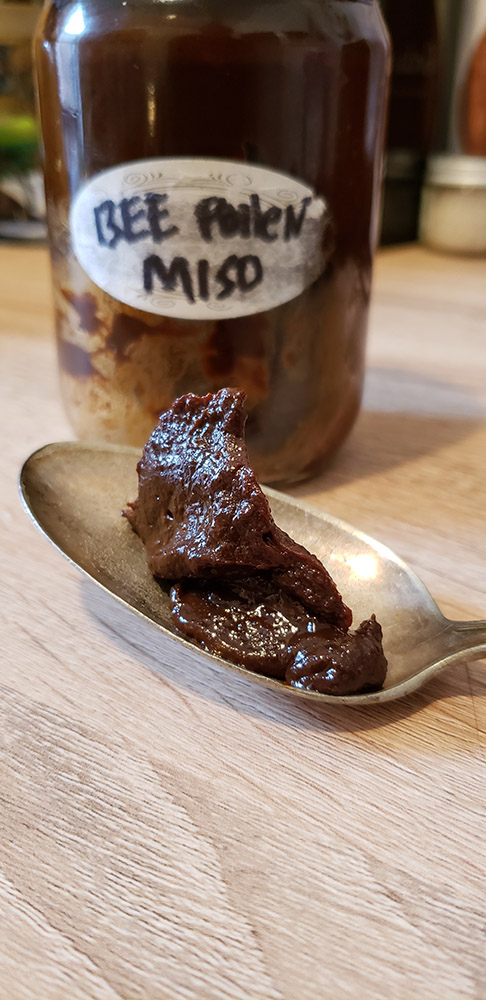
Chef Chris Scott's Bee Pollen Miso
The "Top Chef" finalist shares how he developed his floral, unctuous umami bomb.
When describing my food style or the way that I cook, I’d say it’s pretty simple. My philosophy is to let the food do the “talking” and let it tell you what it wants to become. Now, you can only achieve this if you know about the food or the ingredients.
Take an heirloom tomato for example. Delicious right off of the vine with its naturally sweet and somewhat acidic boldness, it can be easily paired with a sprinkle of sea salt, a little olive oil, maybe a piece of basil if you wish. An inexperienced chef might bypass all of that to add microcrystalline cellulose with a dash of calcium lactate and xanthan to make some foam or gelee. I get it, it’s fun, shows creativity and pushes the boundaries of cuisine to the next level, but to me, that’s all about putting the attention on the chef or the method rather than the ingredient. That same tomato began its transformation on the vine, and I think of the entire process when it comes to the plants that we grow and eat.
Since I consider myself a purist when it comes to food, I rethink the origins of our food history and heritage across all cultures. Watching bumblebees buzz around fennel fronds and the little yellow flowers on tomato plants at Snug Harbor Farm piqued my curiosity about how honeybees bring pollen from fennel, shiso and any other flowering plant and create this wonderful honey or what would occur if we bring the creation of the bee back to the plant without any man- or chef-made tricks and fancy ingredients. Rather than the bee taking the pollen from the flower and making honey, I am taking pollen to a plant in the natural form of umami.
Many chefs are only interested in the end result rather than learning the process. But we can learn so much from the pollination process, and sometimes working in reverse can even lead us to new flavors. This led me to miso, a seasoning produced by fermenting soybeans with salt and koji (the fungus Aspergillus oryzae). The result is usually a thick paste used for sauces, pickling vegetables, mixing with dashi … the possibilities are endless. And it’s high in protein and rich in vitamins and minerals.
Inspired by "The Noma Guide to Fermentation," I’m combining the texture of miso in an experiment with bee pollen to accentuate the flavor of any vegetable from the garden. Since the dawn of humanity, we have always fermented our foods, from alcoholic beverages made from fruit and honey to various milks fermented to produce yogurt. Cheese, bread, vinegar, kimchi and kombucha are examples that tell the story of how we fermented things due to lack of refrigeration.
Here's my gluten-free method and technique.
Recipe
 Bee Pollen "Miso"
Bee Pollen "Miso"
Yields 1 jar
Ingredients
- 3 cups of bee pollen
- 2 1/4 cups water, room temperature
- 200 grams koji
- 2 1/4 cups water
- 3 tablespoons salt
Directions
- Blend the bee pollen and first 2 1/4 cups of the water until completely liquified.
- Add the koji, salt and the second 2 1/4 cups water and continue blending until liquified.
Here’s the trick: I take this liquid and place it in a rice cooker. I layer a piece of plastic wrap on the liquid and weigh it down with a small plate. Then I close the lid to the rice cooker and press the warm button for a constant 140 F.
I let this sit for three weeks undisturbed, and then I open the rice cooker and give it a stir. I cover again with plastic and close the lid. I let this go for another five days, remove from the rice cooker and place in mason jars with the lids. This will stay in an ambient place for 30 days until it reaches a desired taste — sweet and floral bee pollen, salty umami with sweet undertones and the "funk" from fermentation.
Back to those tomatoes: I slice a piece of my heirloom tomato and sprinkle a little olive oil on it. Then I place it under the salamander and roast until bubbly, about 2 minutes at high heat. Finally, I spread a little bee pollen miso on top and rip some pieces of shiso for more flavor, and that’s it. The dish takes time, but it is simple and delicious without manufacturing or manipulation.
Read more recipes from Chef Chris and explore your own learning process in Culinary Arts.


Add new comment